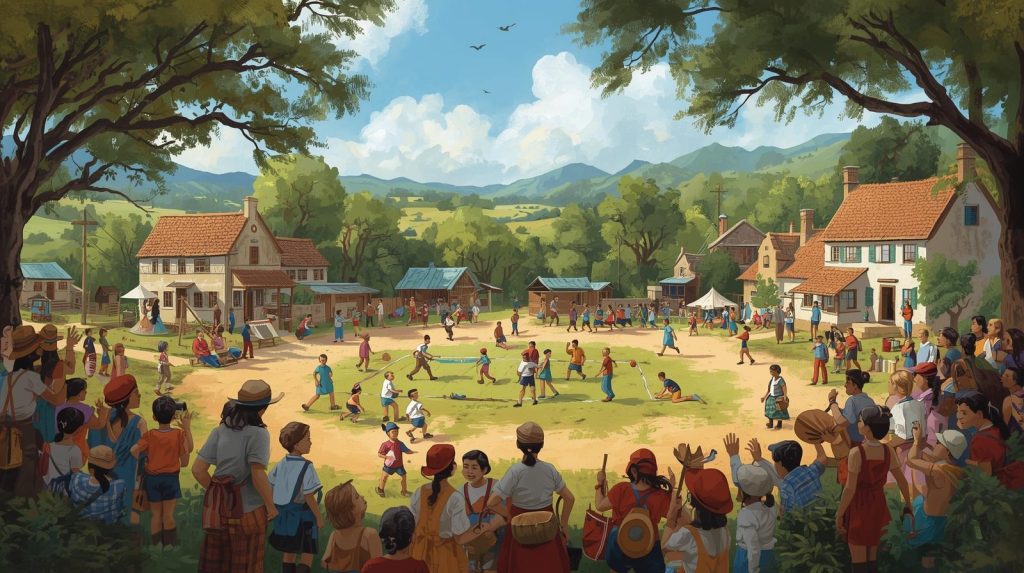
Beyond the Forgotten Fields: The Rich Tapestry of Our Village Games
The nostalgia for games like Lagori and Gilli Danda runs deep, but they were just the headline acts in a festival of play that lasted all year round. The true magic was in the diversity of these games—some tested your speed, others your strength, and many, your mind. As we explore further, we find that what we lost wasn’t just a pastime, but a whole system of learning and community living.
More Treasures from the Trove
Let’s dust off the memories of a few more games that were the heartbeat of village life, especially here in regions like Karnataka.
1. Kho-Kho: The Art of the Chase
This game was pure, unadulterated adrenaline. Two teams, nine players kneeling in a central lane, and a single “chaser” trying to tag an opponent. The beauty of Kho-Kho was its seamless teamwork. The chaser, at their limit, could tap a seated teammate on the back, shouting “Kho!” to pass the baton. It was a high-speed relay of pursuit that taught agility, spatial awareness, and the crucial skill of knowing when to rely on your team. The frantic dodges and the thunderous “Kho!” breaking the evening silence are unforgettable.
2. Kabaddi: The Cant of Courage
Before it became a professional league sport played on mats, Kabaddi was a raw test of power and breath control played in the soft dust (mannu). A single “raider” would cross into the opponent’s territory, chanting “Kabaddi, Kabaddi, Kabaddi…” without taking a breath. Their goal was to tag as many opponents as possible and return to their side. The defenders, meanwhile, would work in a chain to trap the raider. It was a game of immense strength, strategy, and the simple but profound challenge of holding your breath under pressure.
3. Buguri: The Dance of the Spinning Top
In Karnataka, the sight of a Buguri (spinning top) was a common one. This wasn’t just about launching the wooden top; it was an art form. The real skill lay in winding the string perfectly and then, with a flick of the wrist, making the top spin gracefully on the ground. Advanced players would compete to see who could scoop the spinning top back onto their palm with the string or perform other intricate tricks. It taught patience, fine motor skills, and the principles of physics in the most playful way possible.
4. Chowka Bara / Ashta Chamma: The Game of Fate and Strategy
Not all games were about physical exertion. When the afternoon sun was too harsh, out came Chowka Bara. Often drawn with chalk on the floor or scratched into the earth, this was a race-based board game for two or four players. The moves were determined by the throw of cowrie shells. While luck played a big part, the game was rich in strategy—deciding which pawn to move, when to ‘kill’ an opponent’s piece, and how to navigate the safe squares. It was a social, relaxed game that sharpened the mind and often involved the whole family, from children to grandparents.
What We Lost Was More Than Just Play
Exploring these games reveals a deeper loss:
- The Unseen Classroom: These activities were our first lessons in leadership, risk assessment, and conflict resolution. A heated argument over whether a player was “out” taught us more about negotiation than any textbook could.
- The Community Connection: Games were a public affair. Neighbours, parents, and elders would often watch, cheer, and act as informal referees. It strengthened the social fabric of the locality, creating a shared experience that bonded everyone. Older children naturally taught the rules to younger ones, fostering a culture of mentorship.
- A No-Cost Fitness Regimen: Without any fees or fancy equipment, these games kept us incredibly active and healthy. Running, jumping, squatting, and stretching were all built into the fun, promoting robust physical development.
Can We Bring Them Back?
While it’s impossible to completely rewind the clock, the spirit of these games is not entirely lost. Here’s how we might rekindle the flame:
- Community Sports Day: Residential societies in cities like Bengaluru can organize “Native Games” events on weekends or holidays. A simple game of Lagori or Kho-Kho in the community park can be a refreshing change from the usual.
- Incorporate into Schools: Physical education classes could easily include these games. They are inclusive, require minimal equipment, and teach invaluable soft skills alongside physical fitness.
- “Each One, Teach One”: The next time you have a family gathering, take 15 minutes to teach a younger cousin or nephew the simple joy of spinning a Buguri or playing a game of Chowka Bara. Sharing the experience is the best way to preserve it.
The world has changed, but the fundamental need for play, connection, and joy remains. These games are a vital part of our cultural heritage, and by remembering and reviving them, we do more than just play—we reclaim a piece of who we are.


